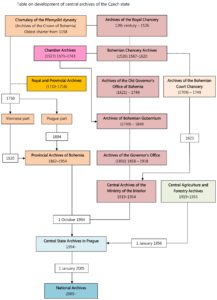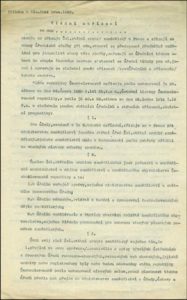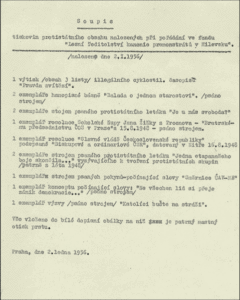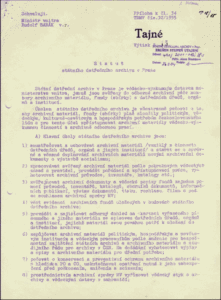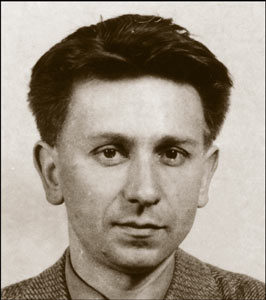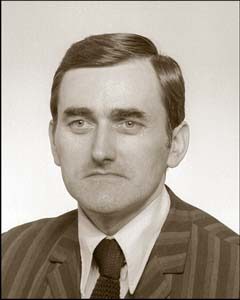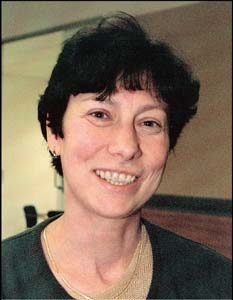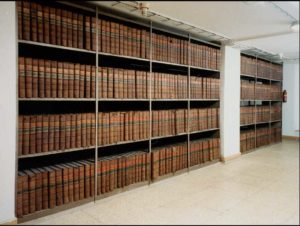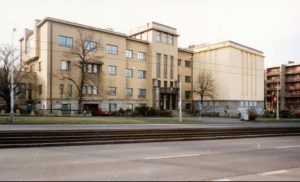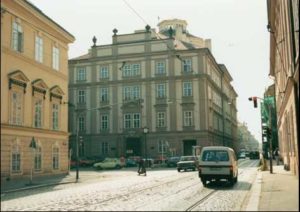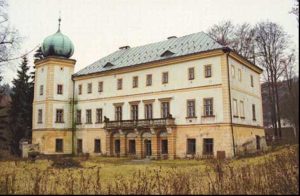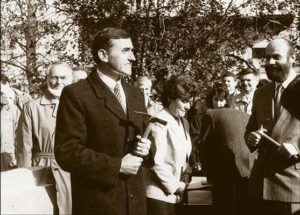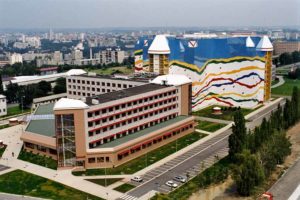From the History of the National Archives
Source: KAĎOREK, Rudolf. Establishment and Development of the Central State Archives in Prague. BENEŠOVÁ, Emilie et al. Nothing and Nobody Should Be Forgotten: On the Anniversary of the Central State Archives of the Czech State 1954–2004. Prague: Central State Archives in Prague, 2004, pp. 13–44. ISBN 80-86712-14-1.
— Brief Overview of Czech Record Keeping Development and Beginnings of the National Archives
— Position of Archives within the Ministry of the Interior
— Internal Organization of the Archives
— Personnel Situation, Systemization, Directors of the Archives
— Spatial Situation of the Archives
Brief Overview of Czech Record Keeping Development and Beginnings of the National Archives
Beginnings of Czech state central archives, at the end of which presently is the National Archives in Prague, can be found as early as in the 12th century. Its development proceeded in two branches. As the first line can be considered the chartulary of the Přemyslid dynasty, presently known as the Archives of the Crown of Bohemia, with oldest preserved charter from 1158. In the middle of the 18th century, the Archives of the Crown of Bohemia was divided into two parts, the Viennese one and the Prague one. The subsequent unification took place far later in the Provincial Archives of Bohemia. This Archives firstly took over the Prague part of the Crown Archives in 1884, the Viennese part was returned to Prague in 1920 as part of the archival separation with Austria. The fonds Archives of the Crown of Bohemia, which contains altogether 2,824 of charters from the years 1158–1935, was recognized as a cultural monument in 1977, and in 1988 the government declared it a national cultural monument by the Government Decree No. 132 of 17 August 1988.
Second line of development of central archives of the Czech state is closely connected with existence of central administrative authorities, starting with the Bohemian Royal Chancery, the existence of which is documented as soon as in 12th century. However the Archives itself, formerly called old registry, is documented up to the year of 1567. Archives name has always corresponded to the name of relevant top authority, which administrated the Archives. As since 16th century, it was firstly the Bohemian Chancery and Chamber Archives, since the early 1620s the Archives of the old Governor’s Office of Bohemia, since 1749 it was the Representation and Chamber Archives, since 1763 the Archives of Bohemian Gubernium, since 1850 the Archives of the Governor’s Office of Bohemia, and at last since 1919 the Archives of the Ministry of the Interior.
Up to 1918, proper attention was not paid to the archives organization. Austrian archives reform, performed in 1894–1895, was implemented until the outbreak of World War I only partially. Almost immediately after creation of independent Czechoslovakia in 1918, the so-called Archives Inquiry, which was actually the conference of leading Czech archivists involved in administration of Czech archives, was called by the Cultural Department of the National Committee to Prague on 20 November 1918. From this conference ensued – among others – the proposal for creation of a general state archives in Prague (a national archives), which was to be created by uniting of the Provincial Archives of Bohemia, the Archives of the Governor’s Office, and the Archives of the National Museum. However, the idea of creating national archives was not enforced during the First Republic due to questions of jurisdiction between the then Ministry of the Interior and Ministry of Education and National Enlightenment.
Therefore, after 1918, only number of sectional archives were created, out of which the most important were the Archives of the Ministry of the Interior established in 1919 from the Archives of the Governor’s Office (its name was changed in 1950 to the Central Archives of the Ministry of the Interior) and the Czechoslovak State Agriculture Archives created in the same year by the Ministry of Agriculture (since 1952 the Central Agriculture and Forestry Archives).
Efforts for new legislative modification of Czechoslovak record keeping were interrupted for several years by occupation of Czechoslovakia and by creation of the Protectorate of Bohemia and Moravia. The record keeping came under German administration, archives preformed the routine activity during the Protectorate era, main attention was paid to securing of archival records from destruction.
After termination of World War II, question of creation of unified archives organization got to the high attention, but it took almost 10 years when the final decision was taken. During course of time, the conception of Ministry of the Interior was enforced, which suggested the creation of archives administration based on the principle of socialization (nationalization) of all archival records and registries, on one-way principle, and on decentralisation of archival service. According to this conception, network of archives was to be created consisting of the central state archives, of regional, district, and local archives, which would have administrated all archival records from the oldest period, and the archives management would have lied within the authority of the Ministry of the Interior. State Commission on Archives established at the Presidium of the Ministry of the Interior by Government Resolution from 9 January 1951 was charged to draw up new legislative regulation of record keeping.
As of 1 November 1953, the newly established Archives Administration Office of the Ministry of the Interior, under conduction of which the last stage of archives reform had proceeded, directly continued in the activities of State Commission on Archives. Long-time effort to create a unified organization of archives was finally completed on 7 May 1954 by adopting the Government Decree No. 29, on Archives. The fact that the archives reform was not carried out by the means of the Act on Archives, but only by far shorter Government Decree, indicates that the implementation was not an easy task.
Establishment of the Central State Archives to 1 October 1954 was announced by the chief of the Archives Administration Office of the Ministry of the Interior, Jaroslav Svoboda at a festive common meeting of employees of the then Central Archives of the Ministry of the Interior and the Provincial Archives of Bohemia, which took place on Monday on 4 October 1954.
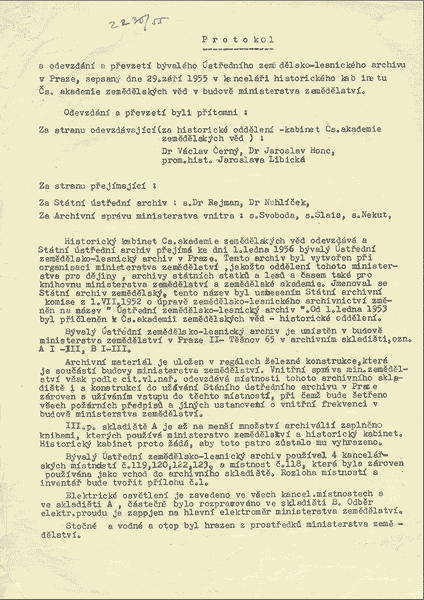
Protocol on handover and assumption of the former Central Agriculture and Forestry Archives in Prague as of 29 September 1955
This date became indisputably an important milestone in the development of Czech record keeping; it completed long-term effort of national archives establishment. However, the act itself, consisting in including of the former Provincial Archives of Bohemia into the Central Archives of the Ministry of the Interior as its new department, and simultaneous change of archives name to the Central State Archives cannot be considered as a break which would immediately affect routine proceedings and activities of the Archives and fortunes of its employees. Neither essential personnel nor administrative changes occurred. Changes, which occurred in relation to establishment of new archives organization, were sequential and their impact had been arising in long-term time horizon. In compliance with Government Decree on Archives, the Central State Archives establishment was completed by including the Central Agriculture and Forestry Archives to 1 January 1956.
The fact that the activities performed by the Central State Archives organically followed the activities of its predecessors, especially the Central Archives of the Ministry of the Interior, is evidenced by the fact that the Central State Archives used as long as to 1967 the Office and Records Management Plan of the Ministry of the Interior from 1950. New Office and Records Management Plan was issued in December 1967 with effect from 1 January 1968. Records Management Plan was then firstly amended and modified to the 1 January 1970, new Records Management Plans were issued in 1975, 1992, and 2003.
In spite of the fact that the Central State Archives ensured after its creation in principle the same agenda as its predecessors, the activities of the Archives were gradually affected especially by applying of principles valid for national economy management. Consistent central planning and archives five-year plans were implemented in whole record keeping, first five-year plan was announced in 1956, and the last one took place in 1986–1990. Working methods had been gradually changed, individual style of work was consistently replaced by the collective approach, which was implemented practically in all archives activities. Methodical instructions and directives binding for all archives were elaborated and issued by the Archives Administration Office of the Ministry of the Interior for particular archives activities. Creation of unified archives organization brought about also some new activities such as uniform registration of archival records, the priorities were changing.
The fonds of political matter from the most recent and recent period, especially the fonds related to working-class movement and to the Communist Party of Czechoslovakia, further the economical fonds and documents reflecting the socialist construction should have been made accessible with priority. These fonds had to be represented in working plans of particular archives by at least 50–60 %.
Distinctive feature for period just preceding the creation of the Central State Archives and for first years of its existence were frequent inspections and checks performed by the Archive Administration Office of the Ministry of the Interior. Checks were focused on the Archives plan fulfilling, ways of control of particular departments, work organization, maintaining of work course and discipline, and especially on the personal and personnel situation, including interpersonal relations in particular working collectives. Results from performed checks and inspections brought interesting view to activities and situation of the Archives, as well as some interesting findings. E.g. the conclusions from inspections of Central State Archives workplaces performed from 5 to 27 April 1955 bring in two places the statement, that the best work efficiency workers are the politically weakest employees with worse personal profile.
During these checks and inspections, number of deficiencies was revealed, however general impression of performed check was never absolutely negative. The inspections were one of the tools, by which the Archives Administration Office performed its control function towards the Central State Archives given by the statute from April 1955, and by which the ideological aspects of archives reform were implemented into practice.
Archival documents related to the beginnings of the existence of the Central State Archives contain number of interesting information and findings, some of which, from today’s point of view and somewhat lifted out of the contemporary context, give even a curious impression. Examples can be the case of the dissemination of pornographic images, discussed in October 1955, or the discovery of printed materials of anti-state content, revealed on 2 January 1956 during the arrangement of the Forestry Directorate fonds of the Premonstratensian Canonry in Milevsko.
Position of Archives within the Ministry of the Interior
Position of the Central State Archives was defined by statute issued by the Order of Minister of the Interior No. 32/1955 from 28 April 1955, according to which the Archives was scientific-research institute of the Ministry of the Interior, to which professional archival treatment of archival material, fonds (collections) of central authorities, bodies, and institutions were entrusted. The Archives was led by the head, appointed by the Deputy Minister of the Interior on the proposal of the Chief of Archives Administration Office.
The task of the head of the Archives, according to this statute, was primarily to manage and organize the activities of the Central State Archives in accordance with the guidelines and instructions of the Archives Administration Office of the Ministry of the Interior. Personnel measures in the Archives lied within the authority of the Chief of the Archives Administration Office, who was to carry them out in cooperation with the head of the Archives. A new function of scientific head was established, whose task was to represent the head of the Archives, to manage archival scientific and research activities of individual departments, to organize and manage scientific meetings, to cooperate with scientific institutions, to organize promotion of archival documents by means of exhibitions, press, etc.
This statute from 1955 was in force until 1970, when it was replaced by the new one by the Decree of the Minister of the Interior of the Czech Socialistic Republic with effect from 1 April 1970.
Although relatively radical proposals emerged in the late 1960s to redefine the position of the Central State Archives, and even in relation to the Archives Administration Office of the Ministry of the Interior, the newly approved statute was eventually by far more restrained. Although the position of the Archives as scientific-research institute of the Ministry of the Interior of the Czech Socialist Republic remained unchanged, the Archives was designed as budget organization directly subordinated to the Ministry of the Interior of the Czech Socialist Republic.
Compared to the statute of 1955, the position of the director of the Archives was strengthened. His task was to manage the work of the Archives, to represent the archive externally in internal and international relations and to act on its behalf. The director’s competencies explicitly mentioned in the statute included the hiring and dismissing of Archives employees, including appointing and removing department heads. Internal organization of the Archives was only mentioned in the statute in general, the detailed organization should have been determined by the Organization Rules, which, however, have not been issued in the end; only a proposal was prepared.
After passing of Act No. 97/1974 Coll. on Archives, replacing the Government Decree on Archives from 1954, new statute was issued with effect from 1 March 1976, according to which the Central State Archives was an institute directly managed and controlled by the Ministry of the Interior. The status of the main scientific research institute in the field of archival science and related disciplines in the Czechoslovak Republic was retained to the Central State Archives.
In connection with the statute, the Organizational Rules were issued to 15 October 1977, supplemented in 1983 by a special amendment to ensure defence preparations. Prepared amendment of the statute and Organization Rules of the Archives in the second half of the 1980s was not carried out. Decree of the Minister of the Interior No. 4 of 31 December 1993 established the Section of Archives Administration at the Civil Administration Department of the Ministry of the Interior, of which the Central State Archives and seven state regional archives also became organizational parts. Organization Rules of the Archives Administration Section at the Civil Administration Department of the Ministry of the Interior were issued in May 1994. The Central State Archives became the direct part of the Ministry of the Interior; it did not have legal personality, nor its own statute and Organization Rules. This situation lasted until 31 July 2002, when, as part of the implementation of the public administration reform, the Central State Archives became according to Act No. 320/2002 Coll. from 1 August 2002 an independent organizational unit of state directly managed by the Ministry of the Interior. Organization Rules of the Central State Archives were issued by the Instruction of the Director No. 18 of 16 September 2003.
Internal Organization of the Archives
During the fifty years of its existence, the Central State Archives has undergone several major reorganizations and a number of minor organizational changes. Overall, however, its organizational development can be assessed as relatively continual and consistent. According to the statute from 1955, the Central State Archives was administratively divided into five departments (internal department, I department – for period of the Czechoslovak Republic and socialist construction, II department – for period of capitalism, III department – for period of feudalism, IV department – estates self-government) and two groups (for archival conservation and technology, and for reading room and library). The former Central Agriculture and Forestry Archives was included into the Archives to 1 January 1956 as its new V department. III and IV departments were united to 1 June 1957; it was performed firstly administratively, the two departments were moved to one building only in 1961. The Agricultural and Forestry Department thus became the IV department, and this designation remained with it until 1996, when it was abolished. The working group for archival fonds after 1945 was established within the I department in 1967. In the same year, four expert commissions were established, which task was to become acquainted with the Archives issues according to their specialty and to discuss and propose measures related to these matters. Namely, following commissions were established: methodical, for document appraisal, editing and publishing, and commission for protection and conservation of archival material. To 1 November 1968, new independent V department was created from group for fonds after 1945, while already in early 1969 the document appraisal section, which consisted of three employees, was created by the resolution of Board Commission within the V department. In 1969, another change in the numbering occurred, when III department (fonds until 1848) became I department and the then I department (1918–1948) became the III department.
The Organization Rules issued on 15 October 1977 determined in Article 5 new organization structure and work contents of particular departments. The Archives was administratively divided into eight departments. Basically, it was not new administrative structure, the Organization Rules affirmed the structure practically used since the early 1970s.
Other partial changes in the organization of the Central State Archives took place in the second half of the 1980s. In January 1986, the Director’s Section was detached from VIII department as the new IX department, but in 1990 the Director’s Department was again incorporated into the VIII department. To 1 January 1986, the reading room was detached from the VI department and included into the II department. An automation section was established within the VI department (library) on 1 January 1987, and from 15 January 1990 also the publishing section. As of 1 April 1990, a new IX department (IT department) was created from these sections. On 26 April 1990, the Commission of Conservators was established at the Central State Archives, as an advisory body of the Archives management for expert issues relating to physical treatment of archival records.
In relation with the relocation of the Central State Archives to new Archives Premises in Prague-Chodovec, a new internal organization of the Archives was issued to 1 January 1997. Already on 1 July 1997, however, the new department of archival fonds of non-state provenance and archival collections was established by the Order of the Director No. 3. The new organization structure valid from 1 January 1997 was comprised of the director’s section and eleven departments (1st department – department of feudalism, 2nd department – department of state administration and provincial self-government 1848–1918, 3rd department – department of state administration 1918–1945/1948, 4th department – department of state administration 1945/1948–1989/1992, 5th department – department of state administration after 1989 and pre-archival care, 6th department – department of non-state fonds, 7th department – department of scientific usage of archival records, 8th department – department of informatics, 9th department – library, 10th department – technical centre, and 11th department – economic-operational department).
The departments were newly numbered in Arabic numerals. The Agricultural and Forestry Department, which was abolished and its fonds were included into the relevant expert departments, no longer appeared in the new organization. In October 2002, the new 12th department (Dept. of Photo-, Phono-, and Cinematographic Documents, Printing, and Public Relations) was established, which was created from the existing section of the 6th department for the management of photo-, phono-, and cinematographic documents, publishing section (detached from the 8th department), and filling office (detached from the director’s section). The new Organization Rules were issued in 2003.
Personnel Situation, Systemization, Directors of the Archives
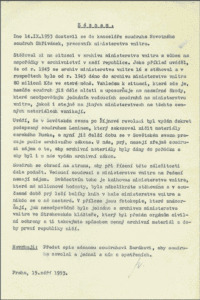
Record of 15 September 1953 concerning a visit of L. Skřivánek in the office of the Secretary of the Central Committee of the Communist Party of Czechoslovakia, where he complained about the situation in the Archives of the Ministry of the Interior and the bad state of archival records. The record including photographs was submitted to the Minister of the Interior
The reorganization of record keeping performed in the 1950s, which included the creation of the Central State Archives, was gradually accompanied by personnel changes, which were influenced by changed socio-political conditions after February 1948. For some employees, the record keeping reform became the springboard for their further archive career, while others were forced to leave the Archives. When deciding on the appointment of senior positions, the decisive criteria were not always professional aspects, no less important, and sometimes decisive, were the political opinions and political reliability of the particular employee. The personal, personnel, and generation exchange, which took place in record keeping, could be documented by dozens of interesting and troubled destinies of particular archivists, some of which were even tragic and very painful.
The first head (the title of director has been used only since 1967) of the newly established Central State Archives became the then head of the Central Archives of the Ministry of the Interior Josef Hron. At the same time, on 1 October 1954, Josef Nuhlíček was appointed the new head of the IV department (formerly the Provincial Archives of Bohemia). Radical exchange in leading positions occurred in the course of 1955. First, Josef Hron was removed from office in March and appointed the head of the 1st department (for the period of Czechoslovak Republic and socialist construction). On 1 April 1955, Rudolf Rejman, the hitherto assistant at the Department of Marxism-Leninism of Charles University, was appointed the new head of the Archives. Simultaneously, a new position of scientific head of the Archives was created. To this position, the current head of the IV department (estates self-government) Josef Nuhlíček was appointed. The exchange in the positions of heads of departments took place at the end of September 1955, when the heads of departments I and II and the head of the conservation and technology group were removed from the office. The new heads of department were appointed to 26 September 1955.
The two-manager governance system, introduced in 1955, was maintained until 1966, when the position of scientific head of the Archives was abolished. Josef Nuhlíček returned to his former position of director of the State Archives in Prague, and Rudolf Rejman left for Tanzania in 1967 as part of an international exchange of experts to become the director of the local National Archives.
Zdeněk Šamberger, the then scientific head of the Archives Administration Office of the Ministry of the Interior, was appointed the new director in April 1967.
In his function, he sought primarily to improve the position of the Archives as an institution (the hitherto valid statute of 1955 no longer corresponded to the real importance of the Archives as a central institution) and to redefine the scope of authority with regard to the Archives Administration Office of the Ministry of the Interior. In the late 1960s, the separation of record keeping from the Ministry of the Interior and its affiliation with the Presidium of the Government was considered, but ultimately not implemented. In 1970, Zdeněk Šamberger was removed from the position of the director in connection with screenings.
Jaroslav Vrbata, his deputy and the then head of the II department, was entrusted with the management of the Archives from 1 August 1970 and to 1 January 1971 appointed the new director, holding this position until his retirement in 1991.
From 30 May 1991 to 30 April 1992, the head of the First Department, Ladislav Pecháček, was entrusted with the management of the Archives. He was replaced in this position in May 1992 by the then deputy director of the Archives, Vácslav Babička. The most important activities he devoted himself to after his appointment as director were tasks related to the construction of the Archives Premises in Prague in Chodovec (started in 1992) and the relocation of archival records to the new Archives Premises. His work is also a new internal organization of the Archives valid since 1997. However, he participated in the full completion of the Archives Premises and its ceremonial opening in 2001 already as the director of the Department of Archives Administration of the Ministry of the Interior (appointed in 2000).
On 1 May 2000, Eva Drašarová, the then head of the II department, was entrusted with the management of the Archives, and to 1 August 2000 appointed the new director.
The personnel status of the Archives has undergone a continuous development since 1955 without major fluctuations, although the number of employees (respectively the number of systemized positions) did not always correspond to the real needs of the Archives. As of 1 April 1955, the Archives had altogether 75 employees, of which 32 were women and 43 men. By 1958, the number of employees had risen to 85 in 92 systemized positions. In 1961, the systemization was reduced to 85 positions, while the number of the employees dropped to 77. This state, at least as far as the number of systemized positions is concerned (the number of employees varied between 73 and 84), remained essentially the same until the second half of the 1960s when in 1968 the number of systemized positions increased to 94. A more significant increase in the number of systemized positions did not occur until the end of the 1970s; in 1980, their number increased to 97. The Central State Archives reached the highest number of employees in 1996, when it employed 182 workers with having a total of 162 systemized positions. However, some of the employees worked part-time. Nevertheless, the reason for this increase was not to strengthen the professional activities of the Archives, but to transfer the positions of housekeepers, cleaners, boiler operators, and security guards to the Archives budget, which occurred as a result of the reorganization carried out at the Ministry of the Interior. Since 1997, there has been a gradual reduction in the number of systemized positions and the number of employees, whose number decreased to 145 in 2003. However, continuous growth of the number of employees mostly did not correspond to the Archives needs, which is obvious when comparing it with the increase in the number of running meters of archival records taken over and their total length. While in 1956 there was an average of 522 running meters of archival material per 1 worker (meaning every worker, not only a professional archivist, but also boiler operators, cleaners, etc.), in 2003 it was already 776 running meters.
The State Central Archives also had to cope with relatively high fluctuation, at least in the first years after its establishment. The fluctuation was caused by poor or unsuitable working environment (dust, humidity, unheated depositories), physically demanding and sometimes stereotyped work (frequent moving) and also rather low income. For the sake of interest it is possible to state that in 1962 the gross salary in the Archives ranged from CSK 900 to 2,400 when the average gross monthly income amounted approximately to CSK 1,440. Another reason could be the health state of some workers. In his report of November 1955, R. Rejman stated that 45 workers of the Archives were verifiably ill, which represented more than 60 % of all employees. Altogether 59 employees left the Archives during 1954–1963. In some cases they were forced to leave, but altogether 26 employees left despite the Archives attempted to keep them. In the course of time the working conditions have improved, although the breakthrough took place rather a short time ago in connection with the completion of the new Archives Premises in Prague 4 – Chodovec. Today, the current employees of the National Archives can work in a modern and pleasant environment, which has a counterpart in only a few countries around the world.
Spatial Situation of the Archives
The Central State Archives took over and followed in very difficult spatial situation of the Central Archives of the Ministry of the Interior. Acquisition of the building of the former Provincial Archives of Bohemia and the premises used by former Central Agriculture and Forestry Archives in the building of the Ministry of Agriculture in Těšnov did not affect the situation significantly, although both buildings belonged among the better, more modern and relatively well equipped ones. This applied particularly to the purpose-built archives building of the Provincial Archives of Bohemia built between 1929 and 1933, although it also required technically and financially demanding reconstruction in the course of time.
During the reconstruction, which started in the early 1980s, individual depositories were repaired, including the installation of air conditioning. In 1986, the reconstruction of the original vault of the Archives of the Crown of Bohemia was completed, during 1987–1990, a new vault was constructed, whose ceremonial opening took place on 30 May 1990 with the participation of the President of the Republic Václav Havel. Considerable attention was paid to the construction of a conservation workplace including the studio for photographing of archival documents and a photographic studio. In 1995, an audio-visual room accommodating 30 people was established.
The premises used by the Agriculture and Forestry Department in the building of the Ministry of Agriculture in Těšnov made a stabilized impression only at first sight. The position of the Archives itself in the basement area of the building, located in the flood zone moreover, was very risky, not to mention a variety of pipework passing directly through the archives depositories. Other shortcomings, such as a missing arrangement room, insufficient social and sanitary facilities and confined office premises, were at least partly removed in the course of time. In the late 1950s, the Archives had to face attempts of the Ministry of Agriculture and Forestry to move the depositories out, as the Ministry intended to construct a bomb shelter accommodating approximately 500 people in these premises. The depository capacity (approximately 5,000 running meters) also turned out to be insufficient for the needs of the Agriculture and Forestry Department and the Archives was forced to look for other premises for deposition of fonds and collections.
The building in Karmelitská 2 in Prague was used by the Archives in the years 1954–2001. Further, depositories in the crypt under the Church of St. Nicholas in the Lesser Town, the former prison building in Mladá Boleslav, the former chateau and later also the school in Jindice, the granary in Ruzyně and the chateau in Adršpach were used for this purpose. At the end of the 70’s and the beginning of the 80’s of the 20th century, several accidents occurred in the building of the Ministry of Agriculture, during which the Archives premises were repeatedly flooded with water. A part of the records situated here got damaged, of which the most damaged ones had to be destroyed later. The largest natural disaster for the Archives premises in Těšnov was the flood in August 2002; however at that time the premises had already been used by the Administration Archives of the Ministry of Agriculture.
The Central State Archives tried to solve its spatial situation by continuous maintenance of the existing depositories and acquisition of new buildings suitable for deposition of accepted archival records, and especially by the attempt to construct a new purpose-built archive building. In 1956, the Archives used altogether seven buildings, but their number was constantly increasing: in 1961 it had ten buildings, in the late 1960s twelve, in the mid-1970s fifteen, and in the mid-1980s it was using already eighteen buildings. Their maintenance, which the Archives secured in cooperation with the relevant departments of the Ministry of the Interior, was extremely demanding in terms of finance and time, as in most of cases the buildings were old, in poor technical condition, and not suitable for storing archival records.
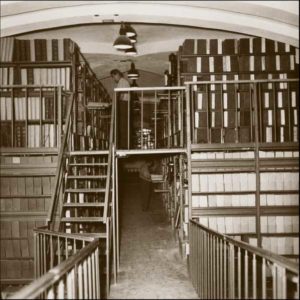
Metal structure in the crypt under the Church of St. Nicholas in the Lesser Town before the move of archival records
From the view of the Archives, there was also a disadvantage consisting in long distance of some of them from Prague (up to 200 km – Broumov, Adršpach), some other were heritage-listed buildings (monastery in Břevnov, Karmelitská 2, Loretánská 6, chateau in Mníšek pod Brdy), which considerably complicated the implementation of building modifications. Even in this situation the Archives attempted to secure the best possible conditions for deposition of its archival records and managed to achieve a number of partial successes. It is possible to rank among them also a three-storey metal structure
erected in the lower crypt under the church of St. Nicholas in the late 1950s, conversion of the chateau in Adršpach carried out in the second half of the 1970s or the abovementioned reconstruction of the building on M. Horákové Street.
The spatial situation became critical at the turn of the 80’s and the 90’s of the 20th century, when the Archives exhausted all spatial reserves and had to restrict accepting of new archival records almost completely. In 1991, the Archives was deployed in a total of 19 buildings, of which 11 were in Prague and 8 outside the city. Of this number, 12 buildings were leased and from nine of which the Archives was given its notice. In the early 1990s, the Archives were put to a great acid test when it took over the archives of the Central Committee of the Communist Party of Czechoslovakia and of the Institute of Marxism-Leninism (on the basis of the Act No. 496/1990 Coll., on Restitution of Property of the Communist Party of Czechoslovakia to the People of Czech and Slovak Federative Republic). The spatial situation of the Archives became complicated also due to the implementation of the Act No. 298/1990 Coll., on Regulation of Certain Property Relations of Monastic Orders and Congregations, on the basis of which the Archives had to vacate the depositories in monasteries in Břevnov and Broumov. In the search for a way out of the critical spatial situation of the Archives, various solutions were considered, including the implementation of extensive internal appraisal process in the fonds and the construction of a records centre. However, it became even more apparent that the only really possible, effective and promising solution of the long-term unbearable situation could be only the construction of new archives premises.
The idea of archives premises construction was not new. Already the Archives of the Ministry of the Interior had tried since 1931 to push through the construction of a purpose-built archive building in Prague-Bubeneč, but without success, unfortunately. After its establishment, the Central State Archives tried several times to revive this idea, but some rather systematic attempts took place only at the turn of the 60’s and the 70’s of the 20th century. In 1973, the then director of the Archives, Jaroslav Vrbata, submitted a draft of archives premises construction to the Archives Administration. On the basis of the proposal, a preparatory study for an investment plan for the construction of the Central Archives Premises in Prague was elaborated in the mid-1970s. According to the presented, but eventually unrealized plan, in addition to the Central State Archives, the State Regional Archives in Prague, and the Archives of the Capital City of Prague, also the Central Administration Archives and the Research Centre, Central Laboratories, the Secondary Archive School, and the Centre for Professional Training of workers of Archives of all tiers were to become a part of the premises.
Also the members of the branch of the Czech Scientific and Technical Society established at the Central State Archives in 1972 participated in promoting the idea of construction of the Archives Premises to a large extent. They collected a large amount of knowledge about new archive buildings in the world and participated in preparation of the source materials required to elaborate the project. The decisive impulse for the construction was the Government Resolution No. 321 of 9 December 1987 that ordered the Minister of the Interior to secure the preparation of pre-project and project documentation for the construction of the building of the Central State Archives and the State Regional Archives in Prague so that the construction could be commenced between 1990 and 1995, and particularly the Resolution of the Government of the Czech Republic No. 213 of 26 June 1991, on the Comprehensive Analysis of Record Keeping in the Czech Republic, that instructed the Minister of Finance in cooperation with the Minister of the Interior to secure in the budget of the Ministry of the Interior funds required for the construction of the Archives Premises in Prague.
Construction in Prague 4 in Chodovec was ceremonially opened by laying the foundation stone on 20 October 1992. The first two depot blocks were completed on 31 December 1994 and their trial operation began on 1 January 1995. Ceremonial opening of this part of Archives Premises took place on 7 April 1995. Already on 3 January 1995, the largest moving in the history of the Archives began. By the end of 1998, a total of 64,617 running meters of archival records have been moved from 13 archives buildings used so far (this amount of archival records was transported by a total of 1,565 lorries).
On 16 January 1995, two unique disinfection chambers, serving primarily to sterilize archival records infested with mildew, were put into operation. By the end of 2003, a total of 32,217 running meters of archival records (of which 27,818 running meters of records belonged to the Central State Archives and 4,399 running meters of records to other archives and institutions) has gone through these chambers. Later, the disinfection chambers have been used also for removal of damages caused by the flood in 2002.
In 1997, the third depot block was completed and the construction of the operational and technical building continued. It was completed with several years’ delay in 2001 and its ceremonial opening took place on 25 and 27 September 2001.
